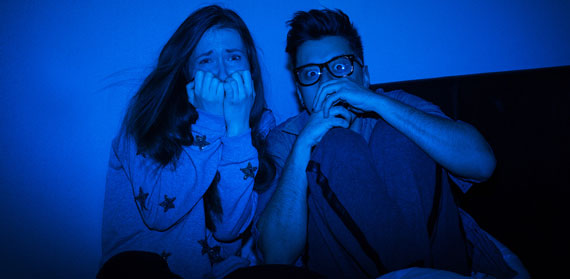Shutterstock
Guest post by Dr. Valerie van Mulukom, Centre for Advances in Behavioural Science
It is the time of the year where the skeletons come out of the closet: Halloween. Time to eat chocolate skulls, to dress up as zombie nurses, and watch scary films. Scary films induce fear, and can disturb us and give us nightmares though – so why watch them? What happens in our brain when we watch a scary film? Why do we react to scary films the way we do? Why are some films scarier than others?
When we watch a film –any film– we activate a brain network called the default mode network. This network supports imagination and comprises of regions all over the brain: visual areas, auditory areas, areas required for language, areas implicated in emotions, and multi-sensory areas which combine all this information into a coherent story.
The interesting thing of the default mode network is that it doesn’t just activate for imagination, it also activates when we recall personal memories. In fact, brain imagining studies have shown that there are very little differences between when we imagine our future and when we recall our past – so how do we know whether something has really happened or is really happening?
The current research on this is still inconclusive – it may have to do with how vividly you can visualise the scenes you are either remembering or imagining, or how easy it is to do so. This is why particularly plausible or vivid visualisations can be so engrossing.
When we watch films, we are imagining along with the narrative and visuals provided to us. Directors use all kinds of ways to pull us into the film, from suspenseful music to creative camera angles, making us forget that we are not actually in the film. Temporarily forgetting that a fictional event is not real is called the ‘suspension of disbelief’. We temporarily have become so absorbed in a fiction that we on some level forget it is not real.
On a physiological level, when we watch frightening films, our heart rate, blood pressure, and respiration increase. In other words, our arousal increases – our body is essentially preparing us for fight or flight. This response is triggered by the amygdala, an almond-shaped set of neurons in the brain that is crucially involved in fear responses. The suspension of disbelief has temporarily blurred the lines between reality and imagination, and your body is responding likewise.
So why would we want to be frightened to the extent that we are ready to engage in fight or flight? Some researchers have suggested that it is exactly that arousal that we are after. Think of it as going into a rollercoaster – we are having a taste of danger without actually being in danger. Your mind and body are on alert, and you may experience an adrenaline rush.
Some films are somehow scarier without being as gory, though. How does that work? Recent research suggests that psychological thrillers are particularly scary because unlike gory films where the spectators know the story and can therefore anticipate the next events in the story, they leave the spectator in the dark, in suspense, until we eventually get to the conclusion and get the full story. Because we know as little as the characters in psychological thrillers, we are drawn into emotions of the protagonist in the film, experiencing the suspense as if we were there with them – and increasing the suspension of disbelief. Gory films on the other hand generally follow a very predictable pattern where a maniac goes on a murderous spree while the heroes of the film fail to stop him, until the very end where the hero(es) prevail and stop or even kill the maniac.
There are limits to the pleasurable experience of scary films though – if the film becomes too realistic, or if as an individual you become more easily absorbed in films, it can become hard to realise you are safe, leaving the body in a fear response, which may cause lingering emotional disturbances, such as nightmares. Thus, the enjoyment of scary films lies in the experience of controlled fear, like in rollercoasters.
We hope you have enjoyable Halloween full of temporarily suspended disbelief and controlled fear!
–
Dr. Valerie van Mulukom is a researcher at Coventry University who has focused on topics such as neurostimulation in response to paranormal beliefs and episodic memory.






Comments are disabled